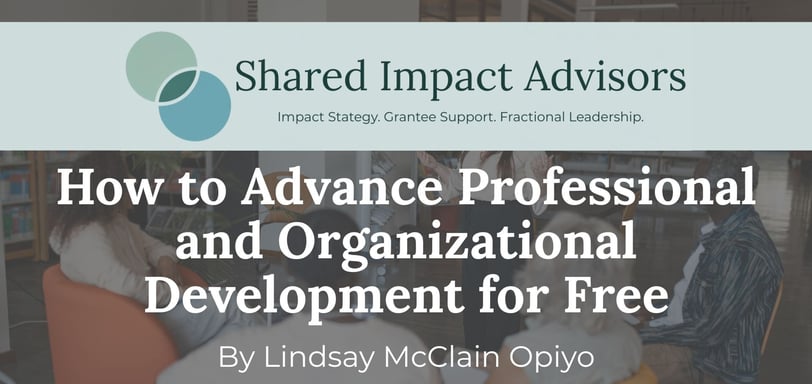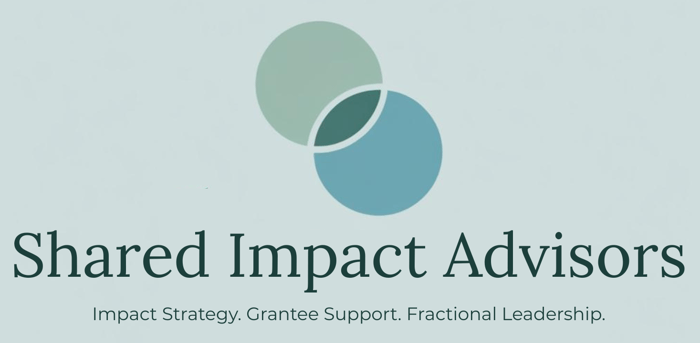How to Advance Professional and Organizational Development for Free
Discover 10 creative, low- or no-cost ways nonprofits and funders can invest in staff and organizational growth—even when budgets are tight.
Lindsay McClain Opiyo
6/5/20255 min read


Last week, I wrapped up a series of coaching sessions with the brilliant Gavan Ambrosini MCC, MA Ed. As we were talking about what it would look like to continue working together, she proposed a trade: we could keep meeting for hour-long sessions, spending half our time with her coaching me—and the other half with me advising her on marketing for her business.
It was a thoughtful way to leverage our respective expertise and keep investing in growth without exchanging money. I loved the idea—and immediately said yes.
When resources are tight, professional and organizational development shouldn’t be the first to go
Over the last few days, I’ve been thinking about how many nonprofits and funders are navigating financial uncertainty right now. One of the first things to get cut in times like these is professional and organizational development: the tools, coaching, and capacity-building efforts that support staff growth and strengthen internal operations.
I understand why—it’s a hard call. I’ve been on executive teams facing those same tough decisions. We often want to prioritize our mission-facing programs and put our internal operations on the back burner when budgets are tight. If it’s a decision between keeping a staff member or keeping a professional development line in the budget, I’m going to prioritize the person and their paycheck.
But if we continually defer investing in our people and internal infrastructure, we risk burning out the very staff we’re trying so hard to retain—and weakening the backbone that makes our programs possible.
That’s why finding creative, low-cost ways to support learning and growth isn’t just helpful—it’s essential for long-term sustainability. Especially when budgets are tight and we’re being asked to do more with less.
So how can we keep building up our teams and organizations when the dollars aren’t there? What’s within reach if we think more expansively about value—not just in terms of money, but also time, skills, networks, and partnerships?
Low-cost/no-cost ways to invest in professional and organizational development
Here are some of the approaches I’ve seen individuals and organizations use (and I’ve used myself) to keep learning and development alive during difficult financial years:
Trade expertise. Like in my opening example, chances are you have something someone else needs, and vice versa. Barter and trade predate currency for a reason. During economic downturns, we can return to that system to keep growing together—no money required.
Find a mentor (or be one). When I moved back to the U.S. after years in Uganda, I knew I had a lot to learn about individual giving. My experience had mainly been with government and institutional grants. I reached out through my university alumni network and the local Association of Fundraising Professionals chapter and found three fundraisers who agreed to meet with me regularly for a few months. In one case, it became a two-way mentorship—they were looking to strengthen their grant writing, which I could help with. Together, we built each other’s skills.
Leverage pro bono platforms. Sites like Catchafire and TrustLaw connect nonprofits with professionals who donate their time. From legal advice to leadership coaching, these platforms offer a lot—especially if you know what you need.
Use your (LinkedIn) network. LinkedIn is full of learning opportunities—especially during moments of change. A few of my favorite sources right now are Grounded Idealist, My Career Pivot, The Bloom, and TechChange, which share timely resources for mission-driven professionals navigating unexpected career transitions. I found them because people in my network posted about them, and have personally benefitted from so many of their free resources over the last few months. (Shoutout to kyle dietrich, Wayan Vota, Jasmine Anouna, and Nick Martin. Thank you for all you’re doing!)
Tap into value-in-kind support from board members. Your board has more to give than money. They can donate air miles so staff can attend a conference, coach junior staff through a complex project, or introduce someone to a helpful contact. Schedule regular check-ins with staff to identify development needs—and bring those to your board to brainstorm creative ways they can help.
Apply for fellowships or capacity-strengthening programs. Thousands of free or low-cost programs exist—especially at the local level, where connections are deeper and competition is lighter. Two of my favorites: the Gratitude Network and the Peacebuilding Academy. Many of these programs offer robust alumni resources, as well, providing continued support for years after completion.
Form a peer council. Groups like Never Search Alone and Dr. Nonprofit show how peer support can sustain us through career changes—and the same works inside organizations. Peer reflection, emotional support, and collaborative problem-solving build resilience and reduce isolation. I especially love when peer groups from across a sector (e.g., Program Officers in regional foundations) meet regularly to exchange learning and support.
Sign up for webinars and podcasts. High-quality, free content is everywhere. Local and national associations often host webinars, and podcasts from social impact leaders are a great way to stay current and inspired. When I was revamping the Generations For Peace U.S. board, several resources I found this way influenced my thinking, and informed the directions we took.
Partner with capacity-building organizations. So nonprofit organizations and funders simply exist to support other nonprofits and funders. Some funders build partnerships with these organizations into their support. For example, last year the folks at Laureus Sport for Good Chicago partnered with Compass Pro Bono to provide free board development and short-term consultancy support to grantees—a win-win-win for funders, nonprofits, and technical partners alike.
Connect with graduate programs. Many graduate and continuing education programs require students to complete pro bono hours or an applied capstone project. Georgetown’s Leadership Coaching Program, as one example, requires students to provide pro bono coaching as part of their training. I’ve seen students post on LinkedIn seeking individuals or organizations willing to be coached, so they can fulfill these experience hours. These collaborations can offer real value on both sides—students gain practical experience, and individuals or teams receive high-quality, no-cost support.
Why it matters
Professional and organizational development isn’t a luxury—it’s what keeps our missions moving forward. A 2019 poll by The NonProfit Times found that nonprofit spending on professional development ranged from $10,000 to over $1 million annually. That’s a massive variation—and a sign of how uneven and inconsistent investment in our people and systems can be.
But development doesn’t have to mean big budgets or expensive consultants. It does mean making a deliberate commitment to learning, reflection, and improvement—even in lean years.
Final thoughts
Capacity-building doesn’t have to be expensive to be effective. What matters most is intention: are we building in the time, space, and support to help our people and systems grow?
Ideally, nonprofits and funders have the resources to invest in development at every level. But in the real world—especially right now—we need to be flexible, creative, and collaborative. We can still invest in ourselves and our organizations, even when the budget is tight.
Let’s keep learning. Let’s keep growing. And let’s do it together.
P.S. At Shared Impact Advisors, we help funders and social impact organizations strengthen their internal capacity—without breaking the bank. From partnering on talent development strategies to facilitating peer learning spaces, we’re always happy to co-create with you low-cost, high-impact ideas. If you're looking for practical ways to keep your team growing and learning, even during a lean year, let’s talk. Book a free consultation here.


